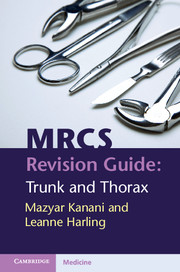Book contents
- Frontmatter
- Contents
- Preface
- Section 1 Clinical surgery in general
- Section 2 Thorax
- Section 3 Trunk
- Chapter 7 Applied surgical anatomy
- Chapter 8 Applied surgical physiology
- Chapter 9 The abdominal wall
- Chapter 10 The abdominal aorta and abdominal aortic aneurysms
- Chapter 11 The oesophagus, stomach and small bowel
- Chapter 12 The liver, biliary tree and pancreas
- Chapter 13 The spleen: splenic trauma and splenectomy
- Chapter 14 The large bowel
- Chapter 15 The rectum and anus
- Chapter 16 The kidneys and genitourinary system
- Bibliography
- Index
Chapter 15 - The rectum and anus
Published online by Cambridge University Press: 05 February 2012
- Frontmatter
- Contents
- Preface
- Section 1 Clinical surgery in general
- Section 2 Thorax
- Section 3 Trunk
- Chapter 7 Applied surgical anatomy
- Chapter 8 Applied surgical physiology
- Chapter 9 The abdominal wall
- Chapter 10 The abdominal aorta and abdominal aortic aneurysms
- Chapter 11 The oesophagus, stomach and small bowel
- Chapter 12 The liver, biliary tree and pancreas
- Chapter 13 The spleen: splenic trauma and splenectomy
- Chapter 14 The large bowel
- Chapter 15 The rectum and anus
- Chapter 16 The kidneys and genitourinary system
- Bibliography
- Index
Summary
Define fissure in ano
Fissure in ano is a longitudinal tear in the epithelial skin and anal mucosa, most commonly in the posterior (6 o'clock) position. Fissures may occur in the 12 o'clock position in approximately 10% of cases and are more common in women following childbirth.
What is the underlying pathophysiology of this condition?
It is thought that the initial insult may involve traumatic injury, e.g., from the passage of hard stool. However, in the majority of cases this heals without leading to development of a chronic anal fissure. It is likely that, in those patients developing anal fissure, there is an underlying abnormality of the internal anal sphincter leading to hypertonicity. This spasm exacerbates the relative ischaemia of the anodermal mucosa posteriorly and as a result can lead to the development of a fissure.
Information
- Type
- Chapter
- Information
- MRCS Revision Guide: Trunk and Thorax , pp. 127 - 137Publisher: Cambridge University PressPrint publication year: 2012
